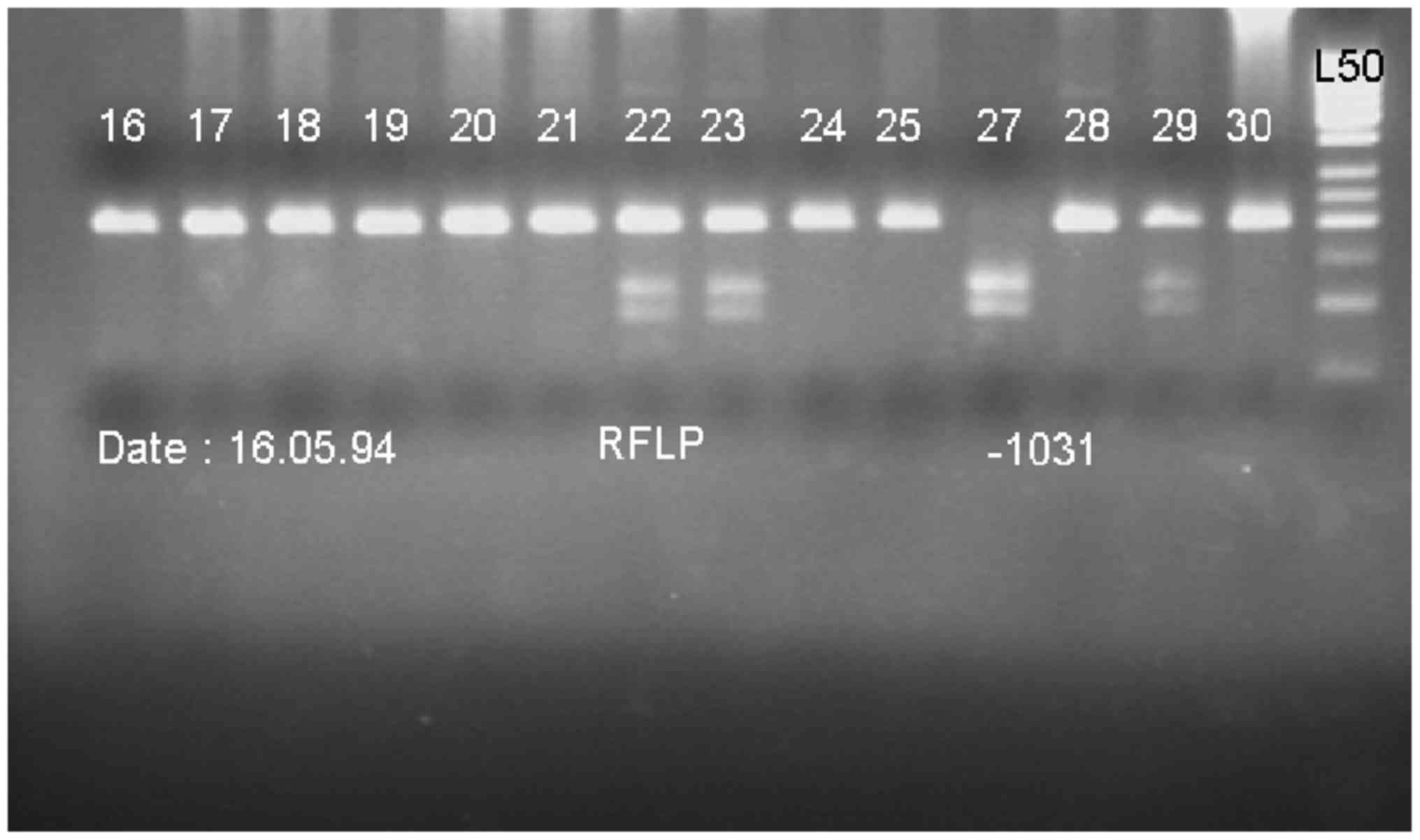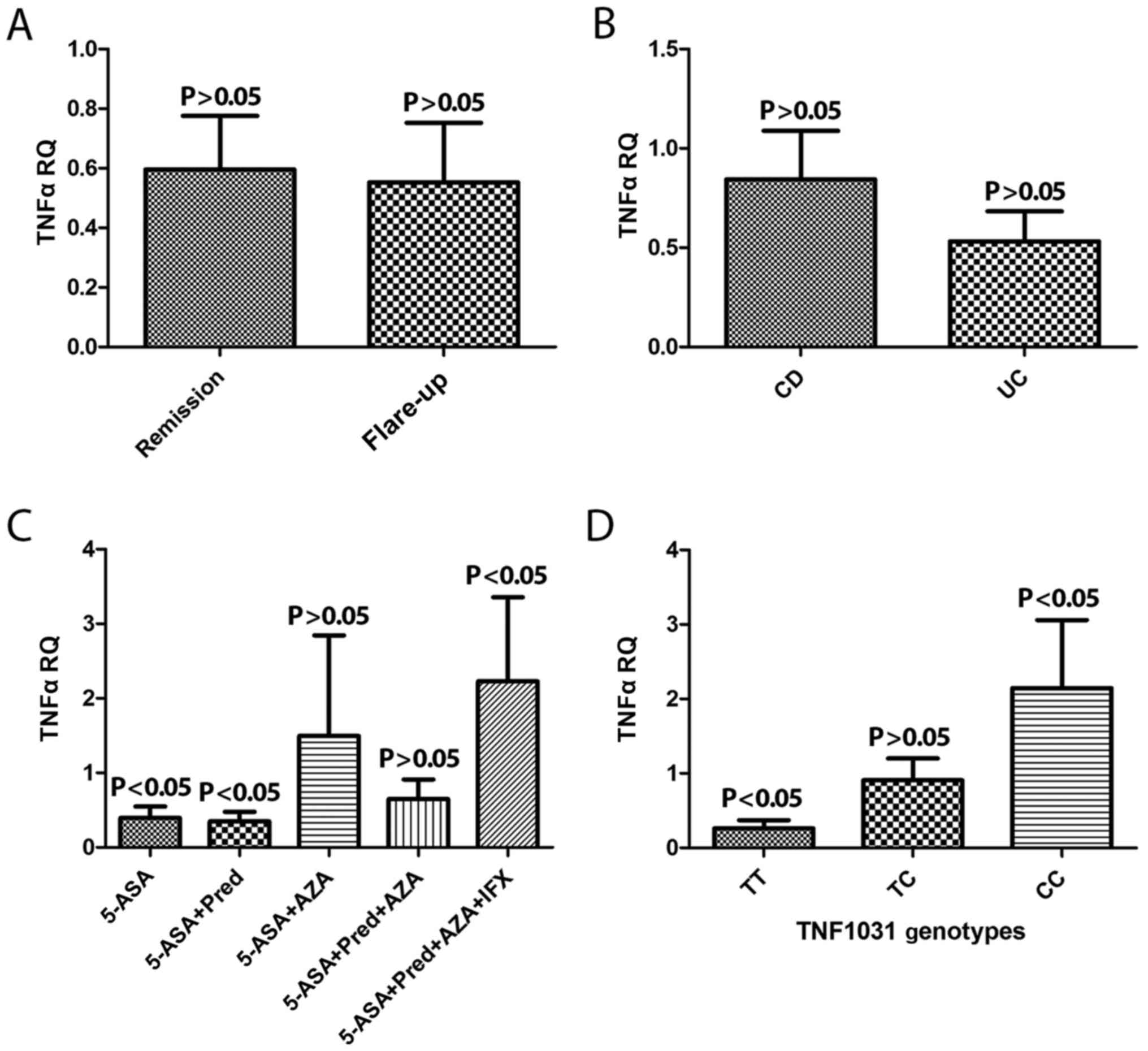|
1
|
Liu TC and Stappenbeck TS: Genetics and
pathogenesis of inflammatory bowel disease. Annu Rev Pathol.
11:127–148. 2016. View Article : Google Scholar : PubMed/NCBI
|
|
2
|
Okamoto R and Watanabe M: Role of
epithelial cells in the pathogenesis and treatment of inflammatory
bowel disease. J Gastroenterol. 51:11–21. 2016. View Article : Google Scholar : PubMed/NCBI
|
|
3
|
Portela F, Dias CC, Caldeira P, Cravo M,
Deus J, Gonçalves R, Lago P, Morna H, Peixe P, Ramos J, et al: The
who-when-why triangle of CAM use among portuguese IBD patients. Dig
Liver Dis. 49:388–396. 2017. View Article : Google Scholar : PubMed/NCBI
|
|
4
|
Bernstein CN, Fried M, Krabshuis JH, Cohen
H, Eliakim R, Fedail S, Gearry R, Goh KL, Hamid S, Khan AG, et al:
World gastroenterology organization practice guidelines for the
diagnosis and management of IBD in 2010. Inflamm Bowel Dis.
16:112–124. 2010. View Article : Google Scholar : PubMed/NCBI
|
|
5
|
Lakatos PL: Recent trends in the
epidemiology of inflammatory bowel diseases: Up or down? World J
Gastroenterol. 12:6102–6108. 2006. View Article : Google Scholar : PubMed/NCBI
|
|
6
|
Cosnes J, Gower-Rousseau C, Seksik P and
Cortot A: Epidemiology and natural history of inflammatory bowel
diseases. Gastroenterology. 140:1785–1794. 2011. View Article : Google Scholar : PubMed/NCBI
|
|
7
|
Ananthakrishnan AN: Epidemiology and risk
factors for IBD. Nat Rev Gastroenterol Hepatol. 12:205–217. 2015.
View Article : Google Scholar : PubMed/NCBI
|
|
8
|
Leppkes M, Neurath MF, Herrmann M and
Becker C: Immune deficiency vs. immune excess in inflammatory bowel
diseases-STAT3 as a rheo-STAT of intestinal homeostasis. J Leukoc
Biol. 99:57–66. 2016. View Article : Google Scholar : PubMed/NCBI
|
|
9
|
Khor B, Gardet A and Xavier RJ: Genetics
and pathogenesis of inflammatory bowel disease. Nature.
474:307–317. 2011. View Article : Google Scholar : PubMed/NCBI
|
|
10
|
Sadler T, Bhasin JM, Xu Y, Barnholz-Sloan
J, Chen Y, Ting AH and Stylianou E: Genome-wide analysis of DNA
methylation and gene expression defines molecular characteristics
of Crohn's disease-associated fibrosis. Clin Epigenetics. 8:302016.
View Article : Google Scholar : PubMed/NCBI
|
|
11
|
McGovern DP, Kugathasan S and Cho JH:
Genetics of inflammatory bowel diseases. Gastroenterology.
149:1163–1176.e2. 2015. View Article : Google Scholar : PubMed/NCBI
|
|
12
|
Francescone R, Hou V and Grivennikov SI:
Cytokines, IBD, and colitis-associated cancer. Inflamm Bowel Dis.
21:409–418. 2015. View Article : Google Scholar : PubMed/NCBI
|
|
13
|
Zhang M, Viennois E, Prasad M, Zhang Y,
Wang L, Zhang Z, Han MK, Xiao B, Xu C, Srinivasan S and Merlin D:
Edible ginger-derived nanoparticles: A novel therapeutic approach
for the prevention and treatment of inflammatory bowel disease and
colitis-associated cancer. Biomaterials. 101:321–340. 2016.
View Article : Google Scholar : PubMed/NCBI
|
|
14
|
Lykouras D, Sampsonas F, Kaparianos A,
Karkoulias K, Tsoukalas G and Spiropoulos K: Human genes in TB
infection: Their role in immune response. Monaldi Arch Chest Dis.
69:24–31. 2008.PubMed/NCBI
|
|
15
|
Mocellin S, Verdi D, Pooley KA and Nitti
D: Genetic variation and gastric cancer risk: A field synopsis and
meta-analysis. Gut. 64:1209–1219. 2015. View Article : Google Scholar : PubMed/NCBI
|
|
16
|
Hajeer AH and Hutchinson IV: TNF-alpha
gene polymorphism: Clinical and biological implications. Microsc
Res Tech. 50:216–228. 2000. View Article : Google Scholar : PubMed/NCBI
|
|
17
|
Li CI, Li TC, Liao LN, Liu CS, Yang CW,
Lin CH, Hsiao JH, Meng NH, Lin WY, Wu FY and Lin CC: Joint effect
of gene-physical activity and the interactions among CRP TNF-α, and
LTA polymorphisms on serum CRP, TNF-α levels and handgrip strength
in community-dwelling elders in Taiwan-TCHS-E. Age (Dordr).
38:462016. View Article : Google Scholar : PubMed/NCBI
|
|
18
|
Nourian M, Asgharian AM and Aghdaei H
Asadzadeh: Lack of association between tumor necrosis factor alpha
(TNFα) gene-1031C/T polymorphisms and susceptibility to
inflammatory bowel disease (IBD). Arak Univ Med Sci J. 19:71–79.
2016.
|
|
19
|
Miller SA, Dykes DD and Polesky HF: A
simple salting out procedure for extracting DNA from human
nucleated cells. Nucleic Acids Res. 16:12151988. View Article : Google Scholar : PubMed/NCBI
|
|
20
|
Moura AC, Lazzari VM, Agnes G, Almeida S,
Giovenardi M and Veiga AB: Transcriptional expression study in the
central nervous system of rats: What gene should be used as
internal control? Einstein (Sao Paulo). 12:336–341. 2014.(In
English, Portuguese). View Article : Google Scholar : PubMed/NCBI
|
|
21
|
Livak KJ and Schmittgen TD: Analysis of
relative gene expression data using real-time quantitative PCR and
the 2(−Delta Delta C(T)) method. Methods. 25:402–408. 2001.
View Article : Google Scholar : PubMed/NCBI
|
|
22
|
Chatzikonstantinou M, Konstantopoulos P,
Stergiopoulos S, Kontzoglou K, Verikokos C, Perrea D and
Dimitroulis D: Calprotectin as a diagnostic tool for inflammatory
bowel diseases. Biomed Rep. 5:403–407. 2016.PubMed/NCBI
|
|
23
|
Takeuchi O: Posttranscriptional regulation
of cytokine mRNA controls the initiation and resolution of
inflammationChronic Inflammation. Springer; pp. 319–332. 2016,
View Article : Google Scholar
|
|
24
|
van Heel DA, Udalova IA, de Silva AP,
McGovern DP, Kinouchi Y, Hull J, Lench NJ, Cardon LR, Carey AH,
Jewell DP and Kwiatkowski D: Inflammatory bowel disease is
associated with a TNF polymorphism that affects an interaction
between the OCT1 and NF(−kappa)B transcription factors. Hum Mol
Genet. 11:1281–1289. 2002. View Article : Google Scholar : PubMed/NCBI
|
|
25
|
Chaparro M, Guerra I, Muñoz-Linares P and
Gisbert JP: Systematic review: Antibodies and anti-TNF-α levels in
inflammatory bowel disease. Aliment Pharmacol Ther. 35:971–986.
2012.PubMed/NCBI
|
|
26
|
Sanchez R, Levy E, Costea F and Sinnett D:
IL-10 and TNF-alpha promoter haplotypes are associated with
childhood Crohn's disease location. World J Gastroenterol.
15:3776–3782. 2009. View Article : Google Scholar : PubMed/NCBI
|
|
27
|
Negoro K, Kinouchi Y, Hiwatashi N,
Takahashi S, Takagi S, Satoh J, Shimosegawa T and Toyota T: Crohn's
disease is associated with novel polymorphisms in the 5′-flanking
region of the tumor necrosis factor gene. Gastroenterology.
117:1062–1068. 1999. View Article : Google Scholar : PubMed/NCBI
|
|
28
|
Naderi N, Farnood A, Dadaei T, Habibi M,
Balaii H, Firouzi F, Mahban A, Soltani M and Zali M: Association of
tumor necrosis factor alpha gene polymorphisms with inflammatory
bowel disease in Iran. Iran J Public Health. 43:630–636.
2014.PubMed/NCBI
|
|
29
|
Tremelling M, Waller S, Bredin F,
Greenfield S and Parkes M: Genetic variants in TNF-alpha but not
DLG5 are associated with inflammatory bowel disease in a large
United Kingdom cohort. Inflamm Bowel Dis. 12:178–184. 2006.
View Article : Google Scholar : PubMed/NCBI
|
|
30
|
Zipperlen K, Peddle L, Melay B, Hefferton
D and Rahman P: Association of TNF-alpha polymorphisms in Crohn
disease. Hum Immunol. 66:56–59. 2005. View Article : Google Scholar : PubMed/NCBI
|
|
31
|
Bonyadi M, Abdolmohammadi R, Jahanafrooz
Z, Somy MH and Khoshbaten M: TNF-alpha gene polymorphisms in
Iranian Azari Turkish patients with inflammatory bowel diseases.
Saudi J Gastroenterol. 20:108–112. 2014. View Article : Google Scholar : PubMed/NCBI
|
|
32
|
Rad R, Dossumbekova A, Neu B, Lang R,
Bauer S, Saur D, Gerhard M and Prinz C: Cytokine gene polymorphisms
influence mucosal cytokine expression, gastric inflammation, and
host specific colonisation during Helicobacter pylori infection.
Gut. 53:1082–1089. 2004. View Article : Google Scholar : PubMed/NCBI
|
|
33
|
Chen G, Wilson R, Wang SH, Zheng HZ,
Walker JJ and McKillop JH: Tumour necrosis factor-alpha (TNF-alpha)
gene polymorphism and expression in pre-eclampsia. Clin Exp
Immunol. 104:154–159. 1996. View Article : Google Scholar : PubMed/NCBI
|











